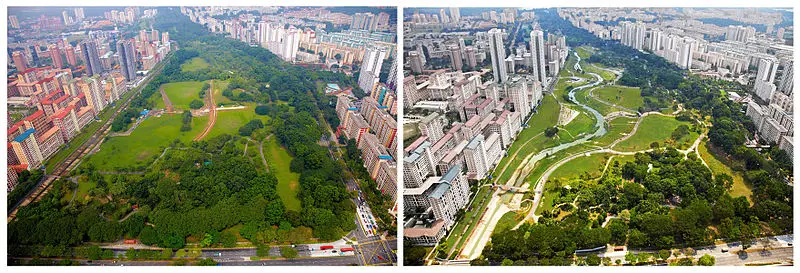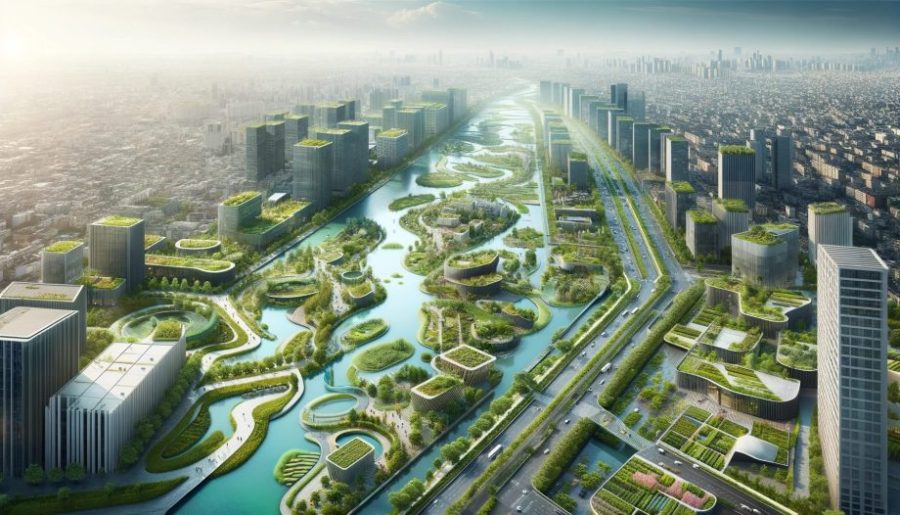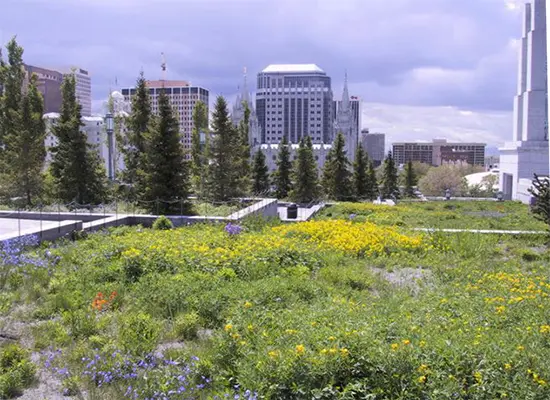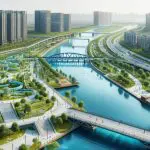
Explore how nature-based solutions for urban flood management can transform cities into greener, safer spaces with eco-friendly approaches!
Urban Flood Management Key Takeaways:
- Nature-based solutions for urban flood management involve using natural processes and elements like green roofs, rain gardens and restored wetlands to mitigate flood risks.
- These eco-friendly approaches enhance urban resilience, improve water quality, and support biodiversity in cityscapes.
Welcome to our deep dive into nature-based solutions for urban flood management!
Imagine cities where green spaces not only beautify but also protect us from flooding.
Let’s explore these innovative, environment-friendly strategies that are reshaping urban landscapes.
Urban Flood Management and Nature-Based Solutions
The Growing Challenge of Urban Flooding
In recent years, the rapid rate of urban expansion has intensified the challenges of urban flood management, making it a major concern for city planners and communities.
Climate Change and Increased Flooding Risks
Climate change has contributed to more frequent and severe weather events, including heavy rainfall leading to urban floods.
Embracing Nature-Based Solutions
These changes demand innovative approaches to water management in urban areas. Nature-based solutions (NBS), like green roofs and rain gardens, have emerged as effective strategies.
Benefits Beyond Flood Management
They not only address urban flood risk management but also offer benefits like improved water quality, ecosystem services, and enhanced green space.
Setting the Stage for Sustainable Urban Planning
This blog post delves into how integrating NBS into urban planning can be a game-changer in sustainably managing urban floods, providing economic development, and contributing to environmental health and human well-being.

The Complexity of Urban Floods
Urban areas face unique challenges in flood management. This section explores the intricate dynamics of urban floods, highlighting how land use changes and the world’s growing urban population exacerbate flood risks.
Causes of Urban Flooding
- Urbanization and Surface Runoff: Increased paving and construction reduce the land’s natural ability to absorb rainwater, leading to higher surface runoff.
- Climate Change and Extreme Events: Climate change contributes to more intense and frequent extreme weather events, including heavy rainfall, intensifying urban flood risks.
Impact of Urban Floods on Communities
- Economic and Property Damages: Urban floods often result in significant economic losses and negatively impact property values.
- Health and Social Impacts: Floods in urban settings can lead to health hazards and disrupt community cohesion and well-being.
Traditional Urban Flood Management Strategies
- Grey Infrastructure: Traditional approaches rely heavily on grey infrastructure like sewers and flood barriers.
- Challenges with Conventional Methods: These methods often fall short in managing the increasing frequency and severity of urban floods, necessitating a shift towards more sustainable solutions.
Transitioning to Integrated Urban Flood Management
- Incorporating NBS: Recognizing the limitations of grey infrastructure, there’s a growing focus on integrated urban flood management, blending traditional methods with NBS.
- The Role of Spatial Planning: Effective urban planning is critical in implementing integrated approaches for flood risk reduction.
Understanding Urban Flood Management Table
| Cause | Impact |
|---|---|
| Urbanization | Increased surface runoff, reduced natural absorption |
| Climate Change | More intense and frequent rainfall, increased flood events |
| Inadequate Drainage | Overflowing of drainage systems, waterlogging |
In a Nutshell:
This section delves into the complexities of urban flood management, emphasizing the causes, impacts, and traditional management strategies while setting the stage for the introduction of Nature-Based Solutions.
Nature-Based Solutions: An Overview
Defining Nature-Based Solutions in Urban Contexts
Nature-based solutions (NBS) involve using natural processes and elements to address environmental challenges.
This section defines NBS and explains its application in urban flood management.
Types and Examples of NBS
- Green Infrastructure: Includes features like green roofs, urban forests, and rain gardens.
- Sustainable Urban Drainage Systems (SUDS): Systems designed to manage water runoff more sustainably.
The Multifaceted Benefits of NBS
- Ecosystem Services: NBS contributes to biodiversity conservation and provides essential natural services.
- Improving Water Quality: By reducing soil erosion and managing runoff, NBS enhances urban water quality.
- Carbon Sequestration: NBS like urban greenery can absorb carbon, aiding in climate change mitigation.
Integrating NBS with Urban Development
- Urban Planning and Green Space: NBS should be integrated into urban planning to maximize green space and natural habitats.
- Economic and Social Benefits: Beyond environmental impacts, NBS contributes to economic growth and improves social benefits like recreational opportunities.
Challenges and Opportunities
- Overcoming Barriers: Addressing challenges in implementing NBS in urban settings.
- Future Research and Development: The need for ongoing research to optimize the effectiveness of NBS.
Nature-Based Solutions: An Overview Table
| NBS Type | Description | Benefits |
|---|---|---|
| Green Roofs | Roof surfaces covered with vegetation | Reduces runoff, improves air quality |
| Rain Gardens | Depressed areas in landscapes designed to absorb rainwater | Enhances groundwater recharge, habitat creation |
| Urban Wetlands | Wetland areas integrated into urban environments | Flood mitigation, biodiversity support |
| Permeable Pavements | Porous surfaces that allow water to percolate into the ground | Reduces runoff, recharges groundwater |
In a Nutshell:
This section provides a comprehensive overview of Nature-Based Solutions, their types, benefits, and integration into urban environments.
Read more: Nature-Based Solutions to Climate Change
Effectiveness and Implementation of NBS

Evaluating the Effectiveness of NBS in Urban Flood Management
Nature-based solutions have shown promising results in managing urban floods, but their effectiveness varies depending on specific urban settings and climate conditions.
Case Studies and Research Findings

- Singapore’s ABC Waters Program: An initiative that includes rain gardens and bioretention swales to reduce urban flooding. The project has successfully decreased surface runoff and improved water quality in urban areas.
- Philadelphia’s Green City, Clean Waters Program: This project utilizes green infrastructure like porous pavement and stormwater tree trenches. It has notably reduced stormwater runoff and sewer overflows.
Comprehensive Literature Review on NBS
- Recent Studies: Research indicates that NBS can lower flood peaks by up to 20% and increase biodiversity in urban areas. Studies emphasize the cost-effectiveness of NBS in long-term urban flood management.
Addressing Implementation Challenges
Identifying Key Barriers
- Land Use Conflicts: Limited availability of space in densely built urban areas.
- Policy and Regulatory Hurdles: Inconsistent policy frameworks that do not always support NBS implementation.
Strategies for Overcoming Challenges
- Public-Private Partnerships: Encouraging collaboration between government and private sector for land use and funding.
- Policy Integration: Advocating for policies that incorporate NBS into urban planning and development guidelines.
Collaborative Approaches for NBS Implementation
Engaging Diverse Stakeholders
- Community Engagement Programs: Involving local communities in planning and maintaining NBS projects, like community rain gardens.
- Expert Panels and Workshops: Organizing platforms for knowledge exchange between urban planners, ecologists, and engineers.
Technical Assistance and Advisory Services
- World Bank’s Urban Flood Management Initiatives: Offering technical and financial support for integrating NBS in urban flood management.
- Asian Development Bank’s Sustainable Urbanization Programs: Providing guidance on implementing NBS in rapidly urbanizing cities in Asia.
The Holistic Approach to Urban Flood Risk Management
Integrating NBS with Traditional Infrastructure
- Combined Systems: Utilizing NBS alongside conventional drainage systems to maximize flood mitigation.
- Adaptive Urban Design: Designing urban spaces that integrate green spaces and traditional infrastructure for enhanced resilience.
Benefits of Integrated Approaches
- Environmental and Social Gains: Demonstrating how combined NBS and grey infrastructure solutions enhance biodiversity, recreational spaces, and community well-being.
- Economic Efficiency: Highlighting cost savings in flood management and maintenance by integrating NBS with existing urban infrastructure.
Effectiveness and Implementation of NBS Table
| Challenge | Strategy |
|---|---|
| Land Requirement | Identifying suitable public and private lands |
| Stakeholder Engagement | Involving community and local stakeholders |
| Long-term Maintenance | Developing sustainable maintenance plans |
| Cost | Securing funding and financial incentives |
In a Nutshell:
This section focuses on the practical aspects of implementing Nature-Based Solutions, examining their effectiveness, challenges, and the importance of a holistic approach to urban flood risk management.
Getting Involved with NBS Projects

Community Involvement in NBS for Urban Flood Management
Active participation from local communities is vital for the successful implementation of Nature-Based Solutions in managing urban floods.
This section provides guidance on how individuals and groups can contribute.
Ways to Get Involved in Local NBS Initiatives
Joining Local Flood Action Groups
- Finding Local Groups: Research and connect with local organizations like the National Flood Forum or local watershed associations actively involved in flood risk management.
- Participation Opportunities: Volunteer for local projects, attend meetings and participate in community planning sessions to provide input and support for NBS initiatives.
Participating in Sustainable Practices
- Individual Actions: Plant native trees and shrubs in your yard or community spaces to improve water absorption and reduce runoff.
- Community Greening Projects: Join or initiate community projects like community gardens, green roof installations, or neighborhood clean-up efforts to enhance local green spaces.
Navigating Administrative Processes
Understanding Permissions and Regulations
- Researching Local Requirements: Consult your city’s planning and zoning department for guidelines on implementing NBS, such as creating a rain garden or installing permeable pavement.
- Permit Application Process: Understand the process for obtaining necessary permits for NBS projects, including timelines and documentation requirements.
Seeking Support from Authorities
- Engaging with Local Government: Reach out to local environmental agencies or planning departments for guidance and support in implementing NBS.
- Accessing Financial Assistance: Inquire about grants, subsidies, or technical assistance available for residents or community groups undertaking NBS projects.
Contributions to Urban Flood Risk Reduction
Community Contributions to NBS
- Educational Outreach: Engage in educating the community about the benefits of NBS, organizing workshops or informational sessions.
- Volunteering for Projects: Contribute time to local NBS projects like planting days, maintenance of community rain gardens, or monitoring the effectiveness of implemented solutions.
Collaborative Efforts for Greater Impact
- Building Partnerships: Foster partnerships between residents, local businesses, non-profits, and government bodies to support larger NBS projects.
- Community Advocacy: Advocate for the inclusion of NBS in urban planning and development, participating in public forums and city council meetings to influence policy decisions.
In a Nutshell:
This section highlights the importance of community involvement in Nature-Based Solutions for urban flood management, offering practical advice on how individuals and groups can participate and contribute.
Technological Advancements and Innovations in Nature-Based Solutions

Introduction to Technological Innovations in NBS
Technological advancements are revolutionizing Nature-Based Solutions (NBS) for urban flood management.
From smart sensors to advanced materials, this section uncovers how technology is enhancing the efficiency and effectiveness of NBS.
Smart Water Management Systems
Sensor Networks in Green Spaces
- What They Do: Sensor networks in parks and gardens keep an eye on moisture levels. This helps distribute water smartly and prevents flooding.
- Why It Matters: These sensors make sure water goes where it’s needed, keeping our green spaces lush and our streets flood-free.
IoT for Water System Management
- How It Works: Internet of Things (IoT) gadgets collect real-time data and help manage water systems from a distance.
- Benefits: This tech makes water management super efficient, tackling flood risks right from our smartphones or computers.
Advancements in Green Infrastructure
Next-Gen Green Roofs
- The Innovation: Green roofs are getting an upgrade with materials that are lighter and soak up more water.
- Advantages: These improvements mean better insulation for buildings and more rainwater absorbed, lessening flood risks.
Easy-to-Install Rain Gardens
- Modular Designs: Rain gardens are now available in easy-to-install modules, perfect for urban spaces.
- Why It’s Cool: These modules make setting up rain gardens a breeze, helping cities manage rainwater more effectively.
Data-Driven NBS Design and Planning
GIS in Flood Management
- Utilizing Tech: Geographic Information Systems (GIS) help plan where to place NBS for maximum impact.
- Impact: This tech ensures NBS are positioned just right to combat urban flooding.
Modeling Tools for NBS
- Tools at Work: Advanced software predicts how well NBS will handle floods in different scenarios.
Several advanced software tools are widely used for predicting and analyzing the effectiveness of Nature-Based Solutions (NBS) in managing floods under various scenarios.
Here are some notable examples:
- HEC-RAS (Hydrologic Engineering Center’s River Analysis System): Developed by the U.S. Army Corps of Engineers, HEC-RAS is a powerful tool for modeling water flow, especially in riverine systems. It’s used to simulate how different NBS, like restored floodplains or wetlands, affect flood peaks and water distribution.
- SWMM (Stormwater Management Model): Created by the U.S. Environmental Protection Agency, SWMM is designed for urban areas. It helps in modeling the effectiveness of NBS like rain gardens, green roofs, and permeable pavements in reducing urban runoff and mitigating flood risks.
- MIKE FLOOD: Developed by DHI, MIKE FLOOD integrates river, urban, and coastal flood modeling. It’s used for evaluating the combined effects of various NBS strategies in complex urban environments, considering factors like climate change and land use changes.
- GIS (Geographic Information Systems): GIS platforms, such as ArcGIS or QGIS, are used for mapping and spatial analysis. They help in identifying optimal locations for NBS based on topography, land use, and flood risk areas.
- i-Tree Tools: Developed by the USDA Forest Service, i-Tree Tools assess the benefits and values of trees and forests in urban areas. It’s useful for understanding how urban tree planting, an NBS strategy, contributes to reducing flood risks and improving water quality.
- Flood Modeller: This tool offers a range of modeling capabilities for rivers, floodplains, and urban areas. It’s used for assessing the impacts of NBS on flood flow paths, extents, and depths.
- AquaFlood: Specifically designed for urban flood simulations, AquaFlood helps in evaluating the performance of NBS-like blue-green infrastructure in urban flood mitigation.
These tools are instrumental in the planning, implementation, and management of NBS for urban flood control.
They provide crucial insights into how various NBSs perform under different conditions, aiding policymakers, urban planners, and environmentalists in making informed decisions.
- Why Use Them: These tools help us understand the best ways to use NBS before we even start building.
Success Stories in Tech-Enhanced NBS
Sensor-Powered Wetlands
- Case Study: Some cities have wetlands equipped with sensors, successfully controlling floodwater.
- Takeaway: This shows how merging nature with tech can be a powerful tool against floods.
Case Study on Sensor-Equipped Wetlands
Case Study: Copenhagen’s Climate-Resilient Wetlands
- Project Overview: In Copenhagen, Denmark, an innovative project has transformed urban wetlands into smart, sensor-equipped ecosystems. The city, known for its commitment to sustainability, integrated advanced sensor networks into the wetlands at Tåsinge Plads and Sankt Kjelds Square.
- Technology in Action: These sensors monitor rainfall, water levels, and soil moisture in real time. They are part of a broader system called the ‘Cloudburst Management Plan‘, which aims to make Copenhagen resilient to heavy rains and flooding.
- Effective Flood Management: During heavy rain, the sensors activate and manage water flow, directing excess water away from streets and into the wetlands. This process not only reduces the risk of urban flooding but also ensures that the wetlands are adequately watered.
- Environmental Benefits: Beyond flood management, these wetlands provide habitats for wildlife, improve local biodiversity, and create recreational spaces for the community. They also help in purifying urban runoff water, enhancing overall urban water quality.
- Community Impact: This project has not only helped in managing flood risks but also transformed urban spaces into green, vibrant areas. It serves as a model for other cities looking to integrate technology with nature-based solutions for urban challenges.
This case study from Copenhagen illustrates how the integration of sensor technology in wetlands can effectively manage urban flood risks while providing ecological and social benefits.
It showcases a practical application of marrying technology with nature-based solutions, offering valuable insights for other urban areas facing similar challenges.
High-Tech Green Roofs: In Practice

Green roofs are evolving from simple plantings to high-tech solutions that significantly contribute to urban flood management.
Here’s a closer look at how some urban areas are incorporating advanced technologies into their green roof designs:
Example 1: The Smart Green Roof System in Berlin, Germany
- Technology Used: Berlin has implemented smart green roofs equipped with sensor technology and automated irrigation systems. These sensors monitor soil moisture, temperature, and weather conditions.
- Benefits: The system automatically adjusts water retention and drainage based on real-time data, optimizing the roof’s capacity to manage rainwater, thereby reducing urban runoff and mitigating flood risks.
Example 2: Chicago City Hall’s Green Roof, USA
- Advanced Features: Chicago City Hall’s green roof is an excellent example of combining vegetation with technology. It includes a variety of plants, reflective coatings, and moisture-retaining layers.
- Impact on Flood Management: This green roof has demonstrated a significant reduction in stormwater runoff, along with reducing the urban heat island effect and improving local air quality.
Example 3: Solar Green Roofs in Singapore
- Innovative Integration: In Singapore, some green roofs are integrated with solar panels, termed ‘bio solar roofs’. This combination not only supports vegetation but also generates renewable energy.
- Flood Management and Sustainability: These roofs play a dual role in managing stormwater and providing sustainable energy, showcasing an innovative approach to urban environmental management.
Example 4: The Water-Recycling Green Roof in Tokyo, Japan
- Cutting-Edge System: Tokyo features green roofs that include advanced water-recycling systems. These systems capture and store rainwater, which is then used for irrigation and other non-potable purposes.
- Efficiency in Flood Control: By storing rainwater, these green roofs help reduce peak flow during heavy rainfall events, easing the pressure on urban drainage systems.
Example 5: The Dynamic Green Roofs in Rotterdam, Netherlands
- Adaptive Design: Rotterdam’s green roofs are designed to be dynamic and adaptive. They include water storage compartments and controlled drainage mechanisms.
- Role in Urban Water Management: These green roofs are part of Rotterdam’s broader strategy to become more resilient against climate change-induced flooding, effectively managing rainwater during extreme weather events.
In a Nutshell:
High-tech green roofs represent a convergence of ecology and technology, offering multifaceted benefits in urban flood management.
They are pivotal in transforming urban landscapes into more sustainable, resilient, and environmentally friendly spaces.
These examples from cities around the world highlight the potential of innovative green roof technologies in addressing urban flooding challenges.
Predictive Technologies in Flood Management
AI for Flood Prediction
- The Future is Here: AI and machine learning are now predicting floods, giving us a heads-up to prepare.
- Why It’s Helpful: This tech can warn us about floods in advance, helping to keep communities safe.
Drones in Flood Surveillance
- Eyes in the Sky: Drones are being used to keep an eye on flood-prone areas.
- Benefits: They provide real-time updates on flood risks, helping in quick and effective NBS response.
Technological Advancements and Innovations in Nature-Based Solutions

Smart Water Management Systems
Sensor Networks for Monitoring Urban Green Spaces: Urban green spaces are increasingly being equipped with sensor networks that collect data on various environmental parameters.
This data can help in managing urban water resources more effectively and in mitigating flood risks.
These systems often combine active and passive sensing methods to gather comprehensive geospatial and environmental data.
IoT and Remote Management of Urban Water Systems: The integration of Internet of Things (IoT) technologies in urban water management allows for real-time data collection and remote operation of flood management systems.
This technology enables more responsive and adaptable water management strategies in urban areas.
Case Studies: Success Stories in Tech-Enhanced NBS
Innovative Urban Wetland Systems: A case study from the Massachusetts Institute of Technology (MIT) highlights the development of multifunctional urban stormwater wetlands.
Researchers at MIT’s Environmental Fluid Mechanics Lab tested over 30 different wetland designs to optimize water circulation, pollutant removal, and ecosystem health.
Their work led to wetland systems that not only effectively manage stormwater but also enhance the aesthetic, ecological, and recreational quality of urban areas.
Remote sensing of urban green spaces: A review – ScienceDirect
These case studies demonstrate the practical application and benefits of integrating advanced technologies in Nature-Based Solutions for urban flood management.
In a Nutshell:
These innovative approaches highlight the potential of technology in enhancing the efficiency and effectiveness of NBS, offering scalable and adaptable solutions for cities facing increasing urban flood risks.
Policy Framework and Legislation for Nature-Based Solutions in Urban Flood Management
Introduction to Policy and Legal Frameworks
Developing and implementing Nature-Based Solutions (NBS) for urban flood management requires a supportive policy and legal framework.
This section explores how laws and policies can facilitate or hinder the integration and effectiveness of NBS in urban areas.
Global and Regional Policy Frameworks
- FEMA’s Approach to NBS: FEMA provides guidance on integrating NBS into flood risk management, highlighting the importance of understanding risk and leveraging community resources for climate resilience and hazard mitigation planning. This approach underscores the need for policies that support risk management and climate resilience through NBS.
- IUCN’s Legal and Policy Frameworks: The IUCN‘s work in enhancing legal and policy frameworks for NBS in the Western Balkans serves as a case study. They emphasize the necessity of a systematic approach to integrating NBS into development strategies, sectoral policies, and legal instruments, especially for climate change adaptation and disaster risk reduction.
Mainstreaming NBS in Urban Governance
- Connecting Nature Framework: The Connecting Nature Framework, applied in ten European cities, showcases strategies for mainstreaming NBS in urban governance. It demonstrates how cities can institutionalize a systems approach to NBS, fostering inclusive collaborations and reflexive learning. This approach involves changes in governance arrangements, including new organizational, legal, and political rules, and relations between actors.
- Key Steps for Effective Mainstreaming: Identifying stepping stones for building governance capacities in urban areas is crucial. These include creating narratives that align NBS with broader social, political, and business goals, and fostering collaboration with various city departments and stakeholders.
Legal and Policy Challenges and Opportunities
- Barriers to NBS Integration: Common barriers include fragmented and narrow priorities, management responsibilities, and financing frameworks within existing sectoral approaches.
- Creating Enabling Conditions: The development of policies and laws that support and enable NBS is essential. This involves understanding how existing laws and policies already support or hinder NBS, and systematically assessing policy gaps and opportunities for mainstreaming NBS.
In a Nutshell:
This section provides a broad overview of how policy frameworks and legislation can support or hinder the implementation of Nature-Based Solutions in urban flood management.
The examples and strategies discussed here highlight the importance of a coherent legal and policy environment that enables the effective integration of NBS into urban planning and governance.
Comparative Analysis: Nature-Based Solutions vs. Traditional Flood Management
Introduction to Comparative Analysis
Exploring the distinctions and complementarities between Nature-Based Solutions (NBS) and traditional flood management methods offers insights into the evolving landscape of urban flood risk management.
This section provides a comparative analysis of these approaches, considering their effectiveness, costs, and broader impacts.
Nature-Based Solutions (NBS)
- Approach and Implementation: NBS employs natural processes and ecosystems, such as wetlands, green roofs, and permeable surfaces, to mitigate flood risks. They are designed to work with nature to absorb and slow down water flow.
- Benefits: Beyond flood management, NBS offers ecological benefits like biodiversity enhancement, carbon sequestration, and recreational spaces. They also tend to be more adaptable to changing climatic conditions.
- Challenges: NBS can require more land, often privately owned, and entail diverse stakeholder involvement. There’s also a need for more data to support their long-term effectiveness and efficiency in various urban contexts.
Traditional Flood Management
- Approach and Implementation: Traditional methods primarily involve engineered solutions like levees, dams, and drainage systems, focusing on diverting and containing floodwaters.
- Benefits: These methods are often effective in immediate flood risk reduction and are based on well-established engineering practices.
- Challenges: They can be expensive to construct and maintain and might not be as flexible in adapting to climate change. Additionally, they often lack the added environmental and social benefits provided by NBS.
Comparative Insights
- Effectiveness in Different Scenarios: While traditional methods are effective for immediate flood control, NBS provides a more sustainable and long-term approach, especially in the face of climate change.
- Cost Implications: The initial investment for NBS can be higher due to land requirements and planning. However, they often result in lower long-term costs due to their multifunctional benefits and lower maintenance needs.
- Integration for Optimal Results: Combining NBS with traditional methods can offer a more comprehensive and resilient approach to flood management, addressing immediate risks while also enhancing urban environments and ecosystems.
Comparative Analysis: NBS vs Traditional Methods Table
| Criteria | Nature-Based Solutions | Traditional Methods |
|---|---|---|
| Approach | Leverages natural processes | Engineered structures |
| Cost | Varies; can be higher initially | High for large structures |
| Effectiveness | Effective over long term | Immediate but can be limited |
| Environmental Impact | Positive impacts on environment | Can be negative (e.g., habitat loss) |
| Adaptability | High; adaptable to climate change | Lower; less flexible to changes |
In a Nutshell:
The choice between NBS and traditional flood management methods depends on specific local conditions, including urban infrastructure, environmental factors, and social considerations.
A balanced combination of both approaches, tailored to local needs and capacities, can provide the most effective and sustainable flood risk management strategy.
This comparative analysis draws on the understanding that managing floods effectively in today’s world requires a diverse range of strategies, encompassing both traditional engineering solutions and innovative nature-based approaches
Future Trends in Nature-Based Solutions for Urban Flood Management
Introduction to Emerging Trends
The field of urban flood management is rapidly evolving, with Nature-Based Solutions gaining prominence.
This section explores the anticipated future trends that could shape how cities manage flood risks using NBS.
This is based on general trends and predictions in the field of urban flood management and NBS.
Advancements in Technology and Data Analytics
- Enhanced Monitoring and Prediction: Future NBS initiatives are likely to leverage advancements in remote sensing, IoT, and AI for better monitoring, predicting, and managing urban flood risks.
- Integration with Smart City Technologies: The integration of NBS with smart city infrastructures, like smart water management systems, to optimize their effectiveness and adaptability.
Policy and Governance Shifts
- Increasing Policy Emphasis on NBS: A trend towards more policies and governance structures that explicitly support and fund NBS for urban flood management.
- Collaborative Governance Models: The rise of multi-stakeholder governance models, involving community groups, NGOs, and private sectors in the planning and implementation of NBS.
Scaling and Diversifying NBS
- From Pilot Projects to Widespread Implementation: An anticipated shift from small-scale pilot projects to more comprehensive, city-wide NBS strategies.
- Diversifying NBS Approaches: Exploring a wider range of NBS, including novel ecological engineering solutions and hybrid systems that combine natural and built elements.
Climate Change Adaptation and Resilience Building
- Focus on Climate Resilience: NBS are expected to play a crucial role in urban adaptation strategies for climate change, focusing on building long-term resilience.
- Linking NBS to Broader Sustainability Goals: Connecting NBS projects with broader sustainability and resilience goals, such as carbon sequestration, biodiversity conservation, and social well-being.
Community Engagement and Social Innovation
- Enhanced Community Involvement: A trend towards more inclusive and community-driven approaches in NBS planning and implementation.
- Social Innovations and Behavioral Changes: Incorporating social innovations and promoting behavioral changes towards a more sustainable coexistence with urban water systems.
Future Trends in NBS for Urban Flood Management Table
| Trend | Description |
|---|---|
| Technological Advancements | Integration with smart city tech and data analytics |
| Policy Shifts | Increased policy support and funding for NBS |
| Scaling and Diversification | Wider adoption and variety of NBS implementations |
| Climate Change Adaptation | Focus on resilience and long-term sustainability |
| Community Engagement | Greater public participation and social innovation |
In a Nutshell:
The future of urban flood management is poised to be significantly influenced by the advancement and integration of NBS.
These solutions not only address the immediate challenges of urban flooding but also contribute to creating more sustainable, resilient, and livable urban environments.
Urban Flood Management and NBS FAQs
In this section, we address frequently asked questions regarding urban flood management and Nature-Based Solutions (NBS).
These Q&As aim to clarify common concerns and provide deeper insights into how NBS can be effectively used in urban settings.
Q1: What are the most effective NBS for urban areas?
A: The most effective NBS vary by location, but generally include green roofs, sustainable urban drainage systems, and rain gardens.
These solutions help manage surface runoff, enhance green space, and improve water quality in urban settings.
Q2: How can I get involved in NBS projects in my city?
A: You can join local flood action groups, participate in community-driven NBS initiatives, or collaborate with urban planners and environmental organizations.
Local authorities and advisory services often provide information on ongoing projects.
Q3: What are the cost implications of implementing NBS?
A: The costs vary depending on the scale and type of NBS. However, NBS can be cost-effective in the long run due to benefits like flood risk reduction, increased property values, and ecosystem services.
Q4: How does NBS contribute to economic development?
A: NBS can boost economic development by enhancing property values, creating recreational opportunities, and reducing costs associated with flood damages.
They also contribute to job creation in the sectors of green infrastructure and environmental conservation.
Q5: Are NBS effective in all types of urban areas?
A: NBS is versatile but may need to be tailored to specific urban settings. Factors like local climate, land use, and the extent of urbanization influence their effectiveness.
Conclusion: Embracing Nature-Based Solutions for Urban Flood Management
The Future of Urban Flood Management
As cities continue to grow, the integration of Nature-Based Solutions in urban flood management becomes increasingly vital.
This approach not only addresses the immediate challenges of flooding but also contributes to the broader goals of sustainable urban development.
Key Takeaways
- Holistic Approach to Flood Management: The combination of NBS with traditional grey infrastructure offers a more resilient and adaptable solution to urban flooding.
- Economic and Environmental Benefits: NBS provides significant economic advantages and plays a crucial role in environmental conservation and biodiversity.
Call to Action and Resources for Further Learning in Nature-Based Solutions
Introduction to Engagement and Learning
Empowering readers to engage with Nature-Based Solutions (NBS) for urban flood management is essential for their broader adoption and success.
This section provides a call to action and highlights valuable resources for further learning and involvement.
Getting Involved with Local Nature-Based Solutions (NBS) Projects
Join In and Make a Difference
- Be a Part of Local Projects: Jump into local NBS projects! Whether it’s planting trees or joining a rain garden initiative, your hands-on help can make our cities greener and flood-resistant.
- Speak Up for Green Solutions: Got ideas for greener cities? Share them! Attend local meetings or forums and be a voice for nature-based solutions in urban planning.
Learn and Grow
- Online Learning: Fancy learning more about NBS? There are plenty of online courses and webinars waiting for you. Dive into the world of urban flood management from the comfort of your home.
- Go-To Resources: For all things NBS, check out websites loaded with case studies and info. It’s a treasure trove of knowledge for anyone keen on sustainable urban solutions.
Connect with Experts and Communities
- Network with Pros: Chat with experts, urban planners, and green thumbs. Exchange ideas and get inspired to bring NBS to your neighborhood.
- Join Environmental Groups: There are loads of groups and NGOs out there passionate about NBS. Joining one is a fantastic way to meet like-minded folks and contribute to sustainable urban development.
Embrace Tech and Innovation
- Tech Tools at Your Fingertips: From apps to digital platforms, there’s a whole world of tech to help you get involved in NBS projects. It’s fun, easy, and super informative.
- Innovate and Inspire: Keep an eye out for cutting-edge NBS technologies and practices. Your contribution or support can help bring these cool innovations to life in your city.
This friendly guide is all about making it easy and exciting for you to engage with Nature-Based Solutions.
Whether it’s learning, participating, or advocating, there’s a role for everyone in shaping a sustainable urban future!
Conclusion: Taking Action for Sustainable Urban Futures
I urge readers to take proactive steps in learning about and engaging with NBS, emphasizing the collective responsibility in shaping resilient and sustainable urban environments.
This section reinforces the importance of individual and collective actions in driving positive change through NBS for urban flood management.
References
- Government Guidelines on NBS: Use nature-based solutions to reduce flooding in your area – White House – Provides an overview of nature-based solutions for flood management, including their benefits and implementation guidelines.
- World Bank on Urban Flood Management: World Bank’s resources on urban flood management – Offers insights and resources on urban flood risk management and economic development aspects.
- Asian Development Bank’s Initiatives: Asian Development Bank’s urban flood management projects – Showcases pilot projects and best management practices in urban flood management.
- Sustainable Urban Drainage Systems: Sustainable Drainage Systems – Susdrain – Provides comprehensive information on sustainable urban drainage systems, their design, and benefits.
- Green Roofs and Urban Greenery: Green Roofs for Healthy Cities – Offers information on green roofs and their role in urban ecosystems.
- United Nations on Sustainable Development: United Nations Sustainable Development Goals – Details the UN’s sustainable development goals and their relevance to urban flood management. United Nations Sustainable Development Goals
- Research on Climate Change and Urban Flooding: Climate Change and Urban Flooding – ResearchGate – A collection of research papers and studies on the impact of climate change on urban flooding.






